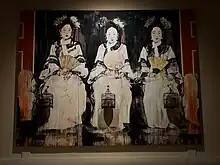
"Three Fujins" was an oil on canvas painting by Hung Liu, a Chinese-American painter born in Changchun, China in 1948,[1] and is currently on display at the Memorial Art Gallery in Rochester, New York. It was finished in 2015 and was put on display at the Memorial Art Gallery in 2016. The dimensions of the painting are 96 x 256 x 12 in (243.8 x 320 x 30.5 cm).[1]
Description
This piece depicts three women adorned in Maoist regime robes, their clothing and makeup suggesting they are concubines.[1] These concubines each hold fans in their laps, sitting symmetrical to each other and facing the observer. All of the concubines are sitting on a singular bench with little room between each other. From the painting's surface extends three bird cages, each cage extending from its respective concubine, giving the painting a distinct three-dimensional aspect.
Influence
Liu was born under the Maoist regime, and the influence of her environment growing up is evident in this particular work.[2] It is strikingly similar to another painting of hers, "The Ocean Is The Dragon's World,"[3] which depicts the Dowager Empress Cixi.[2] She similarly has a birdcage extending from the canvas of the painting as well, showing that though she is in a position of power, she is still confined to the role of a woman of her time.[2]
Style
Using the style of photorealism, Liu bases her paintings off the people in historical photographs that she has taken or others have.[2] These subjects are most often those who have no record of existing, citing that she views her pieces as a type of "memorial site" for the subjects.[4] She often paints directly from these pictures, adding flourishes of her own, such as color, texture, flowers, birds, and other "decorative motifs."[4]
Weeping Realism
Liu's signature technique would be that of "Weeping Realism,"[5] one that she pioneered herself. Weeping Realism takes the realistic and lifelike figures of her paintings and overlays a liberal amount of linseed oil drip over the wet paint, causing the colors to bleed down the canvas and make the crisp image much harder to discern at first glance.[4]
References
- 1 2 3 ""MAG Collection - Three Fujins"". magart.rochester.edu.
- 1 2 3 4 Moser, Joann (Summer 2011). "Interview A Conversation with Hung Liu". American Art. 25 (2): 76–103. doi:10.1086/661970. ISSN 1073-9300.
- ↑ Liu, Hung (2013). Summoning Ghosts: the Art of Hung Liu. Berkeley: University of California Press. p. 151. ISBN 978-0-520-27521-8.
- 1 2 3 Magazine, Smithsonian; Baskind, Samantha. "The Revolutionary Portraiture of Hung Liu". Smithsonian Magazine. Retrieved 2023-12-18.
- ↑ Letha Ch'ien (August 30, 2021). "Hung Liu, in one of her last interviews, reflects on her artistic legacy". San Francisco Chronicle. Retrieved 2023-12-18.